
Rajendra Prasad was an Indian politician, lawyer, journalist and scholar who served as the first president of India from 1950 to 1962. He joined the Indian National Congress during the Indian independence movement and became a major leader from the region of Bihar and Maharashtra. A supporter of Mahatma Gandhi, Prasad was imprisoned by British authorities during the Salt Satyagraha of 1930 and the Quit India movement of 1942. After the constituent assembly 1946 elections, Prasad served as 1st Minister of Food and Agriculture in the central government from 1947 to 1948. Upon independence in 1947, Prasad was elected as President of the Constituent Assembly of India, which prepared the Constitution of India and which served as its provisional Parliament.
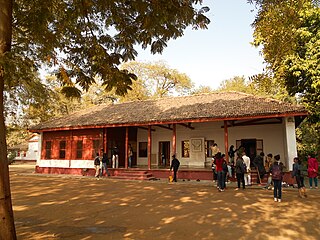
Sabarmati Ashram is located in the Sabarmati suburb of Ahmedabad, Gujarat, adjoining the Ashram Road, on the banks of the River Sabarmati, 4 miles (6.4 km) from the town hall. This was one of the many residences of Mahatma Gandhi who lived at Sabarmati (Gujarat) and Sevagram when he was not travelling across India or in prison. He lived in Sabarmati or Wardha for a total of twelve years with his wife Kasturba Gandhi and followers, including Vinoba Bhave. The Bhagavad Gita was recited here daily as part of the Ashram schedule.

Hajipur is the headquarters and largest city of Vaishali district of the state of Bihar in India. Hajipur is the 16th most populous city of Bihar, besides being the second-fastest developing city, next to Patna. It had a total population of 1.47 lakh as per census 2011. Vaishali district is ranked 8th among 38 districts in Bihar in terms of growth.
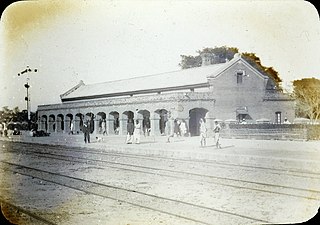
Motihari is a city and headquarters of East Champaran district in the Indian state of Bihar. It is located 80 kilometres west of Muzaffarpur and 152 kilometres northwest of the state capital Patna. In early days the land of Motihari was ruled by different kingdoms as Videha, Sunga, Kanvas. It is also believed that Champaran used to be a major part of King Janak's empire. Mahatma Gandhi Started his famous Satyagraha movement from here.

Gandhi Maidan is a historic ground in Patna, near the banks of the Ganges River, in Bihar, India. The Golghar falls to its west. During the period of 1824–1833, under British rule, it was used as a golf course and horse racing track and was called Patna Lawns. It is spread across 60 acres of land. It has a great political significance as well.
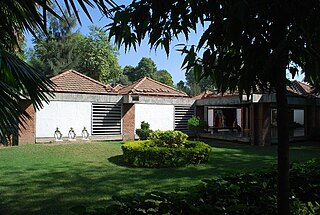
The Gandhi Smarak Sangrahalaya is a museum and public service institution dedicated to preserve the work and memory and commemorate the life of Indian leader Mahatma Gandhi. It is located at Gandhi's Sabarmati Ashram in Ahmedabad, India on the banks of River Sabarmati. It houses tens of thousands of letters to and by Gandhi, as well as photographs and books.

Satyendra Narayan Sinha was an Indian politician and statesman, participant in the Indian independence movement, a leading light of Jaya Prakash Narayan's ‘complete revolution’ movement during the Emergency and a former Chief Minister of Bihar. Affectionately called Chhote Saheb, he was also a seven-time Member of Parliament from the Aurangabad constituency, a three-term Member of the Bihar Legislative Assembly, and a Member of the Bihar Legislative Council once. Regarded to be one of India's most influential regional people of the time, his reputation was synonymous with being a strict disciplinarian and tough taskmaster.
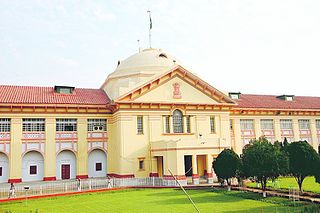
Patna, historically known as Pataliputra, is the capital and largest city of the state of Bihar in India. According to the United Nations, as of 2018, Patna had a population of 2.35 million, making it the 19th largest city in India. Covering 250 square kilometres (97 sq mi) and over 2.5 million people, its urban agglomeration is the 15th largest in India. Patna also serves as the seat of Patna High Court. The Buddhist, Hindu and Jain pilgrimage centres of Vaishali, Rajgir, Nalanda, Bodh Gaya and Pawapuri are nearby and Patna City is a sacred city for Sikhs as the tenth Sikh Guru, Guru Gobind Singh was born here. The modern city of Patna is mainly on the southern bank of the river Ganges. The city also straddles the rivers Sone, Gandak and Punpun. The city is approximately 35 kilometres (22 mi) in length and 16 to 18 kilometres wide.

The Prime Ministers' Museum and Library Society previously known as the Nehru Museum and Library Society is a museum and library in New Delhi, India, which aims to preserve and reconstruct the history of the Indian independence movement. Housed within the Teen Murti House complex, it is an autonomous institution under the Indian Ministry of Culture, and was founded in 1964 after the death of India's first prime minister, Jawaharlal Nehru. It aims to foster academic research on modern and contemporary history. Today, the Nehru Memorial Library is the world's leading resource centre on India's first prime minister. Its archives contain the bulk of Mahatma Gandhi's writings, as well as private papers of Swami Sahajanand Saraswati, C. Rajagopalachari, B. C. Roy, Jayaprakash Narayan, Charan Singh, Sarojini Naidu and Rajkumari Amrit Kaur. In March 2010, it launched a digitization project of its archives, and by June 2011, 867,000 pages of manuscripts and 29,807 photographs had been scanned and 500,000 pages had been uploaded on the digital library website. Amongst noted publications of the NMML are Selected Works of Jawaharlal Nehru, Man of Destiny by Ruskin Bond, and Nehru Anthology (1980).

Gandhi Memorial Museum, established in 1959, is a memorial museum for Mahatma Gandhi located in the city of Madurai in Tamil Nadu, India. Known as Gandhi Museum, it is now one of the five Gandhi Sanghralayas in the country. It includes a part of the blood-stained garment worn by Gandhi when he was assassinated by Nathuram Godse.

Ram Lakhan Singh Yadav, known with the honorific "Sher-e-Bihar", also known as Ramlakhan Babu, was an Indian freedom fighter, educationist, social reformer and politician. The half a century long political journey of Ramlakhan Babu, which started in post-independence era as a member of the Zilla Parishad in 1947, reached the pinnacle of becoming a Union Minister in the Central Government in 1994.He was elected to the 10th Lok Sabha, lower house of the Parliament of India from the Arrah, Bihar in 1991 as a member of the Janata Dal but joined the Congress in controversial circumstances which helped save Narasimha Rao Government in the 28 July 1993 no confidence vote. He was the Minister for Chemicals and Fertilizers in the Narasimha Rao Government.
Gandhi Maidan or Gandhi Maidan Marg is one of the most important thoroughfares in Patna, India. It is a historical place and is considered as a landmark of the city. Gandhi Maidan is the main market and commercial area of Patna with Ashok Rajpath which starts from Gandhi Maidan and Dak Bungalow Crossing and Bailey Road besides Frazer Road, Exhibition Road, Boring Road, and Boring Canal Road. There are many important institutes that have developed around the area of Gandhi Maidan.

On 27 October 2013, a series of bomb blasts rocked the Indian city of Patna, Bihar at a massive election rally for Narendra Modi, the then Bharatiya Janata Party candidate for Prime Minister. Of the estimated 300,000 participants at the "Hunkar" rally, six people were killed and 85 others were injured in eight bomb blasts.
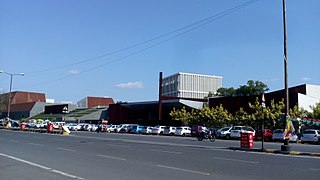
Bihar Museum is a state museum located in Patna. It was partially opened in August 2015. 'The children's museum', the main entrance area, and an orientation theatre were the only parts opened to the public in August 2015. Later, in October 2017 remaining galleries were also opened. More than 100 artifacts were transferred here from Patna Museum.
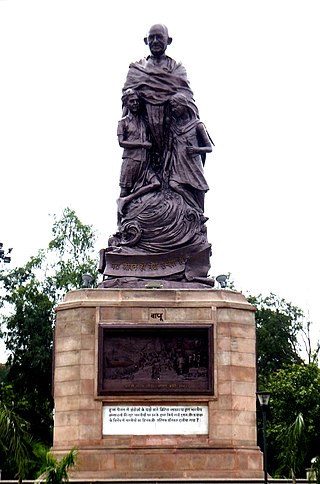
The statue of Mahatma Gandhi in Gandhi Maidan, Patna, is a public monument of India's father of Nation Mahatma Gandhi. The statue is the world's tallest bronze statue of Mahatma Gandhi. It was unveiled on 15 February 2013 by the then chief minister of Bihar, Nitish Kumar. It was established by Government of Bihar at a cost of ₹35 crore. The second tallest Gandhi statue turuvanur Chitradurga taluk and district karnataka
Gandhi Sangrahalaya is the name of several museums in India, most of them named after Mahatma Gandhi. It may refer to:

The Sabhyata Dwar or Civilization Gate is a sandstone arch monument located on the banks on River Ganga in the city of Patna in the Indian state of Bihar. The Sabhyata Dwar is built with a Mauryan-style architecture with a purpose to show the ancient glory of Pataliputra and traditions and culture of the state of Bihar. The monument was first envisioned by the former Lieutenant General Srinivas Kumar Sinha. The 32 metres (105 ft) high structure is taller than Gateway of India by 6 metres (20 ft) and was built at a cost of ₹ 5 crore. The monument is spread over an area of one acre within the campus of Samrat Ashok International Convention Centre. The arches of the Dwar contain inscriptions attributed to Megasthenes, Ashoka, Buddha and Mahavira. Bihar Chief Minister Nitish Kumar inaugurated the monument on 21 May 2018.
















